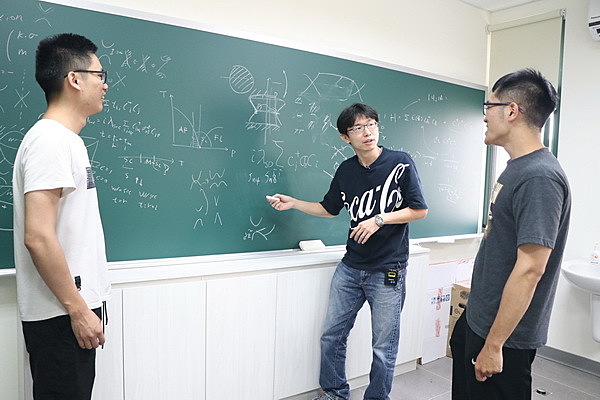若能實現零電阻電流,手機、電腦、冷氣等許多電子產品不僅能避免發熱問題更能大幅減少能源消耗。科學家們認為「量子奇異霍爾效應」是實現零電阻電流的有效途徑之一,因此全球在這方面的相關研究不曾間斷,積極找尋能實現量子奇異霍爾效應的材料。
成大物理系副教授兼成大前沿量子科技研究中心成員張泰榕率領學生,與美國加州大學洛杉磯分校Ni Ni教授、科羅拉多大學波德分校Dan Dessau教授研究團隊合作,分析新合成的量子材料,確認為「本質鐵磁性軸子絕緣體(intrinsic ferromagnetic axion insulator)」。同時,張泰榕團隊也與普林斯頓大學M. Zahid Hasan教授、北京大學賈爽教授合作,共同解析「鐵磁性截半六邊形鑲嵌材料」(Kagome lattice)。張泰榕團隊的理論分析顯示這兩種材料皆有機會實現量子奇異霍爾效應,對零電阻電流的相關應用往前推進了一小步。研究成果分別在7月底發表於國際期刊Science Advances以及Nature。

副教授張泰榕
量子奇異霍爾效應被預期有助於開發次世代低耗能、低耗熱的自旋電子元件,甚至可以促進量子電腦中量子位元的相關發展。2013年,物理學家們透過將磁性元素摻雜進拓樸材料首次實現量子奇異霍爾效應,但實驗條件相當嚴苛,只能在約攝氏零下負270多度才能完成。為此,科學家們開始嘗試不透過複雜的摻雜方式找尋可實現量子奇異霍爾效應的「本質磁性拓樸材料」。
拓樸材料物理、計算物理為張泰榕專業領域之一。2020年Ni Ni教授團隊合成出全新的鐵磁性材料MnBi8Te13,Dan Dessau教授進行光譜量測,但對這個新材料的物理性質仍一片模糊。
因緣際會下Ni教授聯繫上張泰榕,對該材料進行理論分析。張泰榕團隊經過數個月的努力,從Ni Ni團隊提供的元素種類與晶格位置計算出該新材料的物理性質。讓跨國團隊大為意外的是,理論顯示此一新合成的材料竟然是「本質鐵磁性軸子絕緣體」,此種物質態只在數學模型中被提出,從未在真實材料中被發現過。進一步理論分析更顯示,此材料如果做成奈米薄膜,將有機會實現相對高溫的量子奇異霍爾效應。相關研究論文發表於國際期刊Science Advances。
回想起與Ni Ni、Dan Dessau的合作過程,張泰榕說,國際合作要相互信任、溝通、妥協、彼此欣賞成果,還要不爭功,說來簡單,做起來卻需要一段時間的磨合,相當不容易。Ni、Dan時常催趕研究進度,也會對成大團隊所做的理論提出質疑,一點都沒在客氣,雖說是實事求事,但有時也難免讓人滿肚子牢騷。
實現量子奇異霍爾效應是熱門的研究領域。2020年上半年,北京大學賈爽教授團隊合成出「鐵磁性截半六邊形鑲嵌材料」TbMn6Sn6,M. Zahid Hasan教授團隊在掃描穿隧光譜等實驗中觀察到該材料有機會實現零電阻電流的間接證據。但投稿期刊後,3位審稿員皆要求提供理論計算來佐證。張泰榕團隊在此時加入合作,提供理論方面的協助,強化實驗結果的可信度。3方合作成果發表於Nature。
對於能夠順利完成這兩項研究工作,張泰榕笑說「還好兩位博士生田鴻儒、廉上葦夠厲害,不然要在短時間內完成計算與理論分析真是不容易,如果我一個人全包,絕對沒辦法」。張泰榕對兩位學生讚譽有加,他不避諱的說,「研究途中不只一次指導方向錯誤,靠學生努力才導回正途,也多次經由學生的意見,才啟發了新靈感」。

張泰榕老師(中)肯定學生田鴻儒(右)、學生廉上葦(左)的表現
張泰榕表示,就連Ni Ni教授也稱許田、廉兩人,「她好幾次跟我說,Your student has done a fantastic job! I have never imagined that theorists can do such a good job for such a large lattice with magnetism(你的學生做得太棒了!我從沒想過理論學家可以在大型磁性晶格中做出如此出色的成果)。另外投稿到Nature時,審稿員也提到,Their newly introduced calculations show surprisingly good agreement with the experimentally measured dispersion(該研究團隊新提出的計算結果和實驗所量測到的色散數據呈現令人驚訝的一致)」,學生們靠自身努力所贏得的讚譽,實至名歸。
對於老師的稱讚,田鴻儒說,參與張泰榕老師團隊今年是第3年,第1、2年步伐慢,有點辛苦,許多計算沒有得到預期的結果,會想是不是能力不夠。張老師常問學生「你要如何說服我」、「現在卡關了,你有什麼想法」。老師扎實訓練學生的基本功與判斷力,有一天就這麼開竅了。「參與國際合作才了解到,再厲害的團隊也有卡關的時候,以及身處迷霧的研究中,基本功判斷的重要」, 廉上葦表示,與國際團隊合作,對方不吝稱讚田鴻儒與自己,才知道原來自己很不錯,自信心提升許多。
張泰榕最後提到,從事物理研究是因為對自然的本質感到有趣,從基礎研究到實際應用是條漫長的道路,絕不是一人或單一團隊就可以完成。這次的成果只能算是起始階段非常小的一步,未來的進展還需仰賴有興趣的專家們一同努力。
【延伸閱讀】
►什麼是霍爾效應?
感官上導體中電流的行進方向會和所施加的電場同方向,但當你同時外加垂直磁場(z方向)與縱向電場(x方向)卻能違反直覺的量到橫向電導(y方向)。縱向電導只與材料本身有關,是一個常數,而橫向電導則會隨著的磁場加大而連續增加。此特殊的現象稱為霍爾效應。如果你還不死心,持續加大磁場,更離奇的現象就會發生。當磁場超過某個臨界值,橫向電導將不再隨著磁場連續變化,而是呈現完美的不連續量子化台階,與此同時每個量子台階區間內的縱向電導也會消失,形成無電阻的神奇狀態!因電導呈現量子化的不連續分佈,此現象被稱為量子霍爾效應。相關的研究也發現,在鐵磁性材料中(例如鐵)即便沒有外加磁場也能觀察到霍爾效應,稱為奇異霍爾效應。隨之而來一個明顯的問題,世界上存不存在量子奇異霍爾效應的材料?恭喜你已經達到了現有知識的邊緣,這正是目前科學家們一直努力的目標之一。
►量子奇異霍爾效應的小歷史:
從1879年霍爾效應出現以來,科學家對其相關研究一直不曾間斷。到了1980年發現它的量子化版本:量子霍爾效應,可說是量子理論和霍爾效應完美的配合。之後幾年間,科學家們體認到所謂的量子奇異霍爾效應有機會實現零電阻電流。這個特性被預期有助於開發次世代低耗能、低耗熱的自旋電子元件,甚至是促進量子電腦中量子位元的相關發展。2013年,物理學家們透過將磁性元素參雜進拓樸材料,第一次實現了量子奇異霍爾效應。這是一個非常經典的工作,但複雜的元素參雜使得實驗條件相當嚴苛,只能在約攝氏零下負270多度的低溫實驗室內才能完成。直到今日,科學家已踏出成功的一步,能夠不透過複雜的摻雜方式,合成可實現量子奇異霍爾效應的本質磁性拓樸材料。
資料來源: 成大新聞中心, 張泰榕老師
